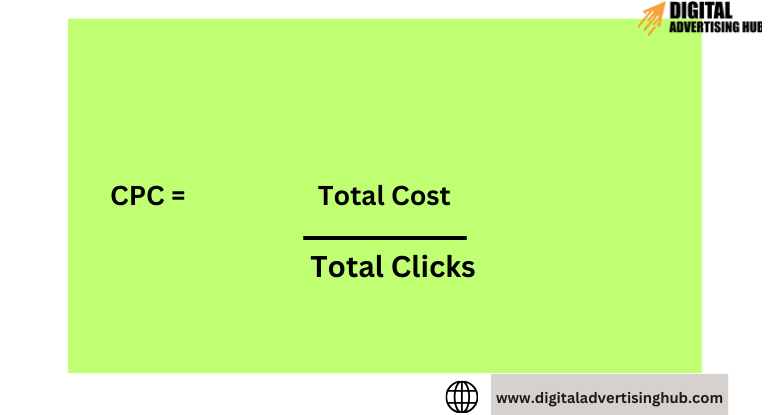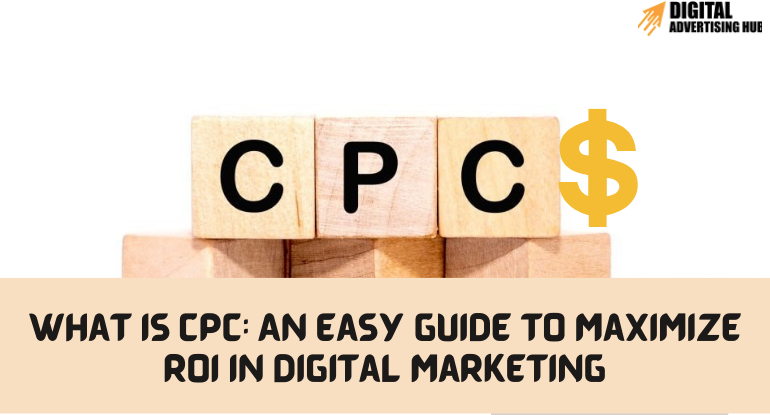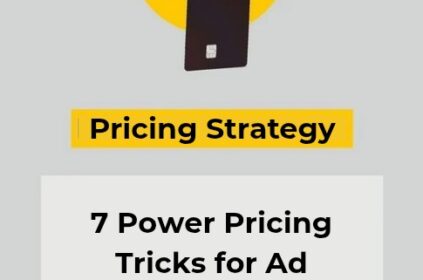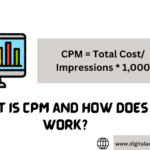Curious about how to harness the power of online advertising to drive targeted traffic without breaking the bank?
In today’s digital age, where online presence and visibility are paramount, advertising has become an integral component of any successful marketing strategy.
Whether you’re a small business owner, a marketer for a large corporation, or an entrepreneur launching a new venture, the ability to effectively reach and engage your target audience online is crucial for driving growth and achieving your business objectives.
At the heart of online advertising lies a multitude of pricing models, each designed to accommodate different goals and budgets.
One such model, which has gained significant prominence due to its efficacy and transparency, is Cost Per Click (CPC). Understanding CPC and its significance is essential for navigating the complex landscape of online advertising and maximizing your return on investment (ROI).
CPC, as the name suggests, is a pricing model where advertisers pay a fee each time a user clicks on their ad. Unlike traditional advertising models that charge based on impressions or time slots, CPC offers a more performance-based approach, allowing advertisers to pay only for actual clicks, thereby ensuring that their investment directly correlates with user engagement.
In today’s blog post, we’ll delve deeper into the world of CPC advertising, exploring its mechanics, significance, best practices, and how you can leverage it to achieve your marketing objectives effectively.
Whether you’re a seasoned marketer looking to optimize your advertising campaigns or a newcomer eager to learn the ropes of online advertising, this guide will provide valuable insights and actionable strategies to help you harness the power of CPC and drive tangible results for your business. So, let’s dive in and unlock the potential of CPC in the realm of online advertising!
What is CPC?
CPC, or Cost Per Click, is a fundamental concept in online advertising that dictates how advertisers are charged for their marketing efforts. At its core, CPC represents the amount of money an advertiser pays each time a user clicks on their ad.
This pricing model is prevalent across various online advertising platforms, including Google Ads, Facebook Ads, LinkedIn Ads, and many others.
Here’s a breakdown of how CPC works
#1. Advertiser Sets a Bid: When setting up an advertising campaign, advertisers specify the maximum amount they’re willing to pay for each click on their ad. This bid can vary depending on factors such as the competitiveness of keywords, the target audience, and the desired ad placement.
#2. Auction System: In online advertising platforms like Google Ads, ads compete for placement in search results or on websites based on factors like relevance, quality, and bid amount.
When a user performs a search or visits a webpage with ad space, the ad platform runs an auction to determine which ads to display and in what order.
#3. Ad Rank Calculation: Advertisers’ bids are combined with other factors like ad quality, relevance, and expected click-through rate to calculate an ad’s Ad Rank. The ad with the highest Ad Rank typically wins the auction and gets displayed to the user.
#4. Actual Cost Per Click: The actual amount an advertiser pays for a click is often lower than their maximum bid. It’s determined by the Ad Rank of the competing ads and the quality of the advertiser’s ad and landing page. Advertisers are charged only when a user clicks on their ad, hence the term “Cost Per Click.”
Here’s an example to illustrate how CPC works in practice:
Let’s say a shoe retailer wants to advertise his latest running shoes on Google Ads. They set a maximum CPC bid of $1.50 for relevant keywords like “running shoes” and “athletic footwear.”
When a user searches for “best running shoes,” Google runs an auction to determine which ads to display. The retailer’s ad, along with several others, participates in the auction.
Based on factors like ad relevance, quality, and bid amount, the retailer’s ad wins the auction and gets displayed at the top of the search results.
If the user clicks on the retailer’s ad, the advertiser pays Google the actual CPC, which might be less than the maximum bid of $1.50, depending on the competitiveness of the auction and the quality of the ad.
By using the CPC pricing model, advertisers can control their spending and allocate their budget more effectively based on the performance of their ads. This transparency and flexibility make CPC a preferred choice for many advertisers seeking measurable results from their online advertising campaigns.
Cost Per Click (CPC) Formula

The formula to calculate Cost Per Click (CPC) is straightforward and essential for understanding the financial aspect of CPC advertising. Here’s the formula:
CPC = Total Cost/Total Clicks
In this formula:
– CPC represents the cost per click, which is the amount an advertiser pays for each click on their ad.
– Total Cost refers to the total amount spent on the advertising campaign.
– Total Clicks denotes the total number of clicks generated by the ad during the specified time period.
By dividing the total cost of the campaign by the total number of clicks received, you can determine the average cost per click. Check our free CPC Calculator.
Why CPC Matters in Online Advertising
CPC holds significant importance in the realm of online advertising for several reasons, making it a favored pricing model for advertisers across industries. Let’s explore why CPC matters:
#1. Cost-effectiveness: One of the primary reasons CPC is favored by advertisers is its cost-effectiveness. Unlike traditional advertising models where advertisers pay for ad placement regardless of user engagement, CPC ensures that you only pay when users interact with your ads by clicking on them.
This pay-for-performance model allows you to allocate your budget more efficiently, focusing your spending on ads that drive actual traffic and engagement.
#2. Control and Flexibility: CPC offers you a high level of control and flexibility over your advertising campaigns. You have the freedom to set your maximum CPC bids, allowing you to determine how much you are willing to pay for each click.
Additionally, you can adjust your bids in real-time based on factors like ad performance, competition, and budget constraints. This granular control enables you to optimize your campaigns for maximum effectiveness and ROI.
#3. ROI-focused Advertising: CPC aligns with the overarching goal of online advertising: driving a positive return on investment (ROI). By paying only for clicks, you can more accurately track the performance of your campaigns and measure your ROI.
You can analyze key metrics such as click-through rate (CTR), conversion rate, and cost per acquisition (CPA) to gauge the effectiveness of your CPC campaigns and make data-driven decisions to optimize your advertising strategy.
#4. Targeted Traffic and Conversions: CPC advertising allows you to target your ads to specific audiences based on factors such as demographics, interests, and online behavior.
This targeted approach ensures that ads are served to users who are most likely to be interested in your products or services, increasing the likelihood of clicks and conversions.
By reaching the right audience with the right message at the right time, you can maximize the impact of your CPC campaigns and drive tangible results for your business.
In essence, CPC offers you a transparent, performance-based pricing model that enables you to achieve your marketing objectives effectively. By leveraging the cost-effectiveness, control, and targeting capabilities of CPC advertising, you can reach your target audience, drive meaningful engagement, and ultimately, generate a positive ROI for your online advertising efforts.
What Are the Best Practices for Optimizing CPC Campaigns?

To ensure the success of your CPC campaigns and maximize your return on investment, it’s essential to implement best practices and optimization strategies. Here are some key tips for optimizing your CPC campaigns:
#1. Keyword Research and Selection:
– Conduct thorough keyword research to identify relevant and high-performing keywords for your ads.
– Use keyword research tools like Google Keyword Planner, SEMrush, or Ahrefs to discover keywords with high search volume and low competition.
– Focus on long-tail keywords and niche-specific terms to target highly relevant audiences and reduce competition.
– Continuously monitor and refine your keyword list based on performance metrics like click-through rate (CTR) and conversion rate.
#2. Ad Copy Optimization:
– Craft compelling and engaging ad copy that resonates with your target audience and entices them to click.
– Highlight unique selling points, promotions, or special offers to capture users’ attention and encourage action.
– Use clear and concise language, and include relevant keywords in your ad copy to improve ad relevance and quality score.
– Test different ad creatives, headlines, and calls-to-action (CTAs) to identify what resonates best with your audience and drives the highest click-through rates.
#3. Landing Page Optimization:
– Ensure that your landing pages are optimized for conversions and provide a seamless user experience.
– Align the messaging and design of your landing pages with your ad copy to create a cohesive user journey.
– Include clear and prominent CTAs that encourage users to take the desired action, whether it’s making a purchase, signing up for a newsletter, or downloading a resource.
– Optimize your landing pages for mobile devices to accommodate users browsing on smartphones and tablets.
– Test different elements of your landing pages, such as headlines, images, and form fields, to identify areas for improvement and increase conversion rates.
#4. Ad Scheduling and Bid Adjustments:
– Analyze the performance of your CPC campaigns over time and identify peak hours or days when your ads perform best.
– Use ad scheduling to adjust your bids based on time of day, day of week, or specific dates to maximize your campaign’s effectiveness.
– Increase your bids during periods of high traffic or competition to ensure that your ads remain competitive and visible to your target audience.
– Decrease your bids during off-peak times or when conversion rates are lower to optimize your budget and maintain a positive ROI.
#5. Continuous Monitoring and Optimization:
– Regularly monitor the performance of your CPC campaigns and track key metrics such as CTR, conversion rate, and cost per acquisition (CPA).
– Use analytics tools and ad platform insights to identify trends, patterns, and areas for improvement.
– Make data-driven decisions to optimize your CPC campaigns, such as adjusting bids, refining targeting criteria, or updating ad creatives.
– Experiment with A/B testing and multivariate testing to compare different campaign elements and determine the most effective strategies for driving clicks and conversions.
By implementing these best practices and optimization strategies, you can maximize the effectiveness of your CPC campaigns, drive targeted traffic to your website, and achieve your marketing goals efficiently.
Remember to continuously monitor and refine your campaigns based on performance data to ensure long-term success and ROI.
Measuring and Analyzing CPC Performance

Measuring the performance of your CPC campaigns is crucial for evaluating their effectiveness, identifying areas for improvement, and maximizing your return on investment (ROI). Here are some key metrics to track and analyze when assessing the performance of your CPC campaigns:
#1. Click-Through Rate (CTR):
– CTR measures the percentage of users who click on your ad after seeing it.
– A high CTR indicates that your ad is compelling and relevant to your target audience, while a low CTR may indicate that your ad needs improvement or that it’s not reaching the right audience.
– Monitor your CTR regularly and compare it to industry benchmarks to gauge the effectiveness of your ad copy, targeting, and overall campaign strategy.
#2. Conversion Rate:
– Conversion rate measures the percentage of users who complete a desired action after clicking on your ad, such as making a purchase, signing up for a newsletter, or filling out a contact form.
– A high conversion rate indicates that your landing page and offer are resonating with users, while a low conversion rate may indicate that your landing page needs optimization or that your offer needs refining.
– Track conversion rate at the campaign, ad group, and keyword levels to identify areas of strength and weakness in your CPC campaigns.
#3. Cost Per Acquisition (CPA):
– CPA measures the average cost of acquiring a new customer or lead through your CPC campaigns.
– Calculate CPA by dividing the total cost of your campaigns by the number of conversions generated.
– A lower CPA indicates that your campaigns are cost-effective and efficient at driving conversions, while a higher CPA may indicate inefficiencies that need to be addressed.
– Set CPA targets based on your budget and business goals, and adjust your campaigns accordingly to achieve your desired CPA.
#4. Return on Investment (ROI):
– ROI measures the profitability of your CPC campaigns by comparing the revenue generated from your campaigns to the total cost of running them.
– Calculate ROI by subtracting the total campaign cost from the total revenue generated, then dividing the result by the total campaign cost and multiplying by 100 to get a percentage.
– A positive ROI indicates that your campaigns are generating more revenue than they cost to run, while a negative ROI may indicate that your campaigns are not delivering the desired results.
– Continuously track and optimize your campaigns to improve ROI and maximize profitability.
#5. Ad Position and Impressions:
– Monitor the average position of your ads in search results or on websites to assess their visibility and competitiveness.
– Higher ad positions typically result in more clicks and impressions, but may also come with higher costs.
– Analyze impression data to understand how often your ads are being shown to users and whether they’re generating sufficient visibility and exposure.
By tracking these key metrics and analyzing the performance of your CPC campaigns, you can make informed decisions to optimize your campaigns, improve their effectiveness, and achieve your marketing objectives.
Use analytics tools and reporting features provided by ad platforms to access detailed performance data and gain insights into the performance of your CPC campaigns. Regular monitoring and optimization are essential for maximizing the impact of your CPC campaigns and driving sustainable results for your business.
Conclusion
Cost Per Click (CPC) has emerged as a cornerstone of online advertising, offering you a transparent and performance-based pricing model that aligns with the goals of driving targeted traffic and achieving measurable results. Throughout this blog post, we’ve explored the intricacies of CPC advertising, from its definition and significance to best practices for optimizing campaigns and measuring performance.
CPC empowers you with the ability to control your spending, target your ads to specific audiences, and pay only for actual clicks, ensuring that your advertising budgets are allocated efficiently and effectively.
By leveraging CPC, you can reach your target audience at the right time with the right message, driving engagement, conversions, and ultimately, revenue for your businesses.
So, as you embark on your next CPC campaign, remember to stay focused, stay agile, and above all, stay committed to delivering value to your audience through targeted, engaging, and impactful advertising. With CPC as your guide, the possibilities are endless, and success is within reach.
Thank you for joining us on this journey through the world of CPC advertising. Here’s to your continued success in the dynamic and ever-evolving world of online marketing. Cheers!










